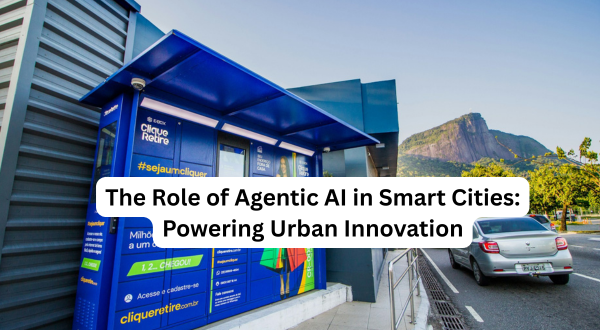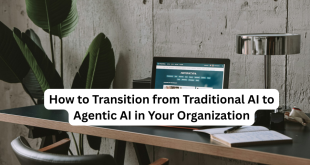As cities grow and urban populations swell—projected to reach 68% of the global population by 2050—the need for smarter, more efficient urban systems has never been greater. Enter Agentic AI, a transformative technology that’s redefining how smart cities operate. Unlike traditional AI, which excels at analyzing data or automating repetitive tasks, Agentic AI takes it a step further by making autonomous decisions in real time, adapting to dynamic urban environments. From optimizing traffic flow to managing energy grids and enhancing public safety, Agentic AI is at the heart of urban innovation in 2025. Let’s explore how this technology is powering the cities of tomorrow.
What is Agentic AI?
Agentic AI refers to intelligent systems capable of independent decision-making and task execution with minimal human intervention. These “agents” perceive their environment, process vast amounts of data, and act to achieve specific goals. In the context of smart cities, Agentic AI integrates with Internet of Things (IoT) devices, 5G networks, and edge computing to manage complex urban systems in real time. Think of it as the brain behind a city’s nervous system, coordinating everything from transportation to waste management.
Transforming Traffic Management
Traffic congestion is a universal urban challenge, costing cities billions annually in lost productivity and emissions. Agentic AI is revolutionizing traffic management by dynamically adjusting to real-time conditions. For example, AI agents analyze data from cameras, sensors, and connected vehicles to optimize traffic signals, reducing wait times by up to 25%, according to studies from Singapore’s Smart Nation initiative. In Los Angeles, AI-powered traffic systems have cut congestion in pilot areas by rerouting vehicles during peak hours and predicting bottlenecks before they occur.
These agents don’t just react—they anticipate. By integrating weather forecasts, event schedules, and historical data, Agentic AI ensures smoother commutes and greener cities. Imagine a rush-hour traffic light that “knows” a concert is ending nearby and adjusts its timing to prevent gridlock. That’s Agentic AI in action.
Powering Sustainable Energy Grids
Energy management is another critical area where Agentic AI shines. Smart cities rely on renewable energy sources like solar and wind, but their variability demands precise coordination. AI agents monitor energy consumption patterns, weather conditions, and grid demands to balance supply and demand autonomously. In Copenhagen, a leader in sustainable urban design, AI-driven systems have reduced energy waste by 15% by predicting peak usage and redistributing power efficiently.
Agentic AI also empowers microgrids, localized energy systems that can operate independently. During outages or extreme weather, AI agents prioritize critical infrastructure—like hospitals or emergency services—ensuring resilience. By 2030, over 50% of urban energy systems are expected to rely on such AI-driven solutions, per Deloitte’s 2025 tech trends report.
Enhancing Public Safety
Safety is a cornerstone of any thriving city, and Agentic AI is making urban spaces more secure. AI agents analyze data from surveillance cameras, social media, and IoT sensors to detect potential threats in real time. For instance, in Tokyo, AI systems identify unusual crowd behavior at train stations, alerting authorities to prevent accidents or stampedes. Similarly, predictive policing models, powered by Agentic AI, analyze crime patterns to deploy resources proactively, reducing response times by up to 20% in pilot programs.
Importantly, these systems are designed with ethics in mind. Transparent algorithms and strict data privacy protocols ensure that AI enhances safety without compromising individual rights—a balance cities like Amsterdam have prioritized in their smart city frameworks.
Streamlining Waste Management
Waste management is a less glamorous but vital aspect of urban life. Agentic AI optimizes collection routes by analyzing bin sensor data, traffic conditions, and disposal schedules. In Seoul, AI-driven waste systems have cut collection costs by 30% and reduced landfill contributions through smarter recycling processes. AI agents even guide residents via apps, notifying them of pickup times or suggesting proper waste sorting, fostering a culture of sustainability.
Challenges and the Path Forward
While Agentic AI holds immense promise, it’s not without challenges. Ensuring data privacy, preventing algorithmic bias, and maintaining cybersecurity are critical concerns. Cities must invest in robust governance frameworks and public trust to scale these systems responsibly. Additionally, the high cost of infrastructure—sensors, 5G networks, and computing power—can be a barrier for smaller cities, though partnerships with tech providers are bridging this gap.
Looking ahead, the integration of Agentic AI with emerging technologies like 6G and quantum computing will unlock even greater potential. By 2030, Gartner predicts that 70% of smart cities will rely on autonomous AI agents for core operations, from disaster response to urban planning.
The Future of Urban Innovation
Agentic AI is more than a technological upgrade—it’s a paradigm shift for how cities function. By enabling real-time, autonomous decision-making, it’s creating urban environments that are more efficient, sustainable, and livable. From reducing carbon footprints to enhancing public safety, the impact of AI agents is already visible in cities like Singapore, Copenhagen, and Seoul. As more cities embrace this technology, the vision of truly smart, citizen-centric urban spaces is becoming a reality.
What’s next? As Agentic AI evolves, expect even smarter cities where every system—transport, energy, safety, and beyond—works in harmony, driven by intelligent agents that anticipate and adapt to our needs. The urban future is here, and it’s powered by Agentic AI.
 UBUCH ubuch | Honest Tech Reviews & Tutorials for Everyone
UBUCH ubuch | Honest Tech Reviews & Tutorials for Everyone




